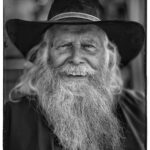A Tale of Tough Love on a Set

A make-up artist that I have worked with frequently over the years, Jan Lendhart, has been reading my posts. And she suggested this story that she recalled us working one.
A Tale of Tough Love on a Set
This was supposed to be fun little gig for a software security company. Just a simple image of a fierce female cop, gun drawn, staring down a cyber criminal. I envisioned a moody, cinematic setup in the studio, shadows slicing across the scene like a noir thriller. Easy, right? Or so I thought.
The client brought her—his favorite model. Young. Good looking. Catwalk material. Certainly too young for the part. Her delicate features and soft charm didn’t scream “hardened cop” to me. She was more runway than precinct. But I shrugged it off and got to work.
We decked her out in a crisp police uniform, badge gleaming under the studio lights. The setup was perfect: dramatic lighting, a sleek prop gun, and a backdrop that worked for the shot. I coached her with precision: “Look tough, like you own the scene. You’re stopping a hacker dead in their tracks. Mad, but in control. Got it?” She nodded, gripping the gun. “Ready? Action!”
I expected a steely glare, a commanding stance. Instead, she channeled Charlie’s Angels on a catwalk. She hoisted the gun with the grace of a ballerina, her grip so dainty it could’ve cradled a teacup. Then, as if posing for a fashion spread, she swiveled her hips right, shoulders left, flashing a smile that belonged in a magazine, not a crime scene. She looked fabulous—utterly, infuriatingly fabulous—but not remotely like the tough cop we needed.
So we did it again with a little more direction.
And again.
And again.
Nothing changed. Her every move whispered glamour. Her instincts were flawless—for a fashion spread. But not for this.
Time slipped away.
I felt it—that moment every photographer dreads: What if I can’t get the shot?
I called a break. Then I made a decision. Not a technical one—a psychological one. A dangerous one. I turned to the client and art director.
“I’m going to push her,” I warned.
“She won’t like it. But it’s the only way.”
They hesitated. Then nodded.
We went back on set and tried it again.
Predictably, she delivered another perfect, infuriatingly feminine pose. That was my cue. I unleashed a tirade that would’ve made a Hollywood director blush. “This is awful!” I bellowed, my voice echoing off the studio walls. “ “This is garbage,” I snapped, loud enough to make the room freeze.
“You’re ruining the shoot. You think this is how a cop stands? You think you’re intimidating anyone? You’re not even close. This is pathetic.”I leaned into the role of the self-righteous, ego-driven director, Her eyes widened, then narrowed. Her cheeks flushed. I kept pushing, ranting until I saw her blood boil, her jaw clench with raw, unfiltered anger. “Now,” I roared, “shoot me!”
Click. Perfection. Her eyes blazed with fury, her stance radiated authority. The gun, no longer a prop, looked like an extension of her wrath. We had the shot—exactly the tough, commanding cop vibe we’d been chasing.
I called it a wrap. As she stormed off set, I offered a quiet apology. She didn’t respond, just marched to the dressing room, changed, and left without a word. I never saw her again. But the shot? I got it!
Directing isn’t about pressing a button. It’s about pulling something out of someone they didn’t know they had.
Sometimes that means light and gentleness. Sometimes, it means turning yourself into the villain, just to let your subject become the hero. I never wanted to hurt her. But in that moment, we needed to see her fire—and we did.

Mel Lindstrom Photography
415-979-9340
info@melphoto.com

